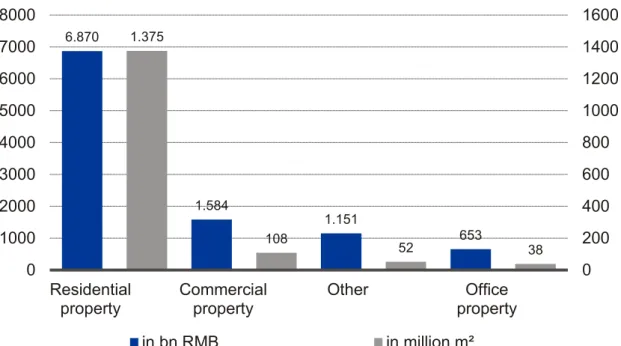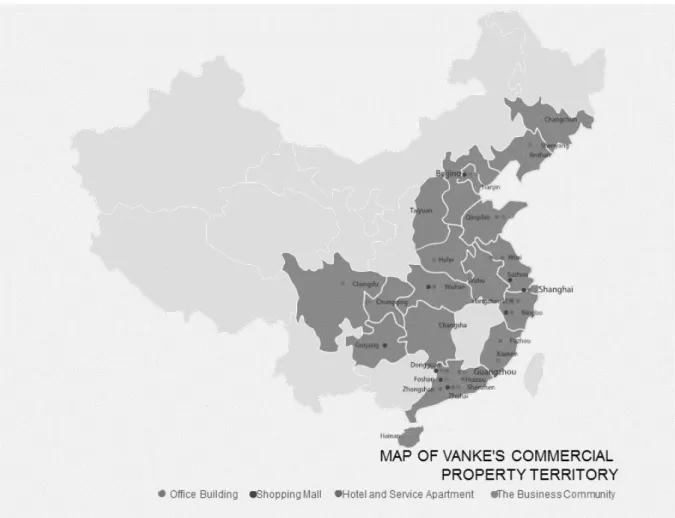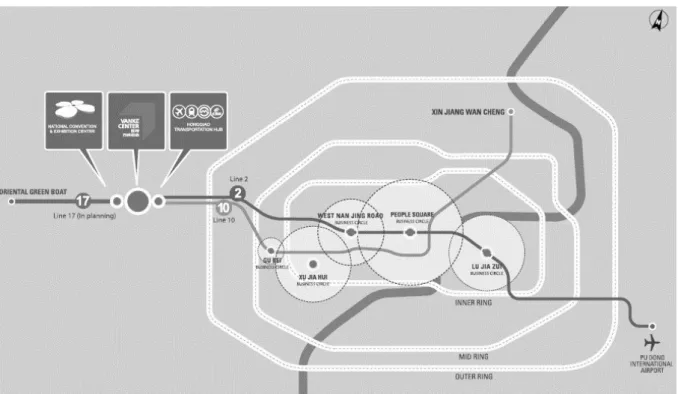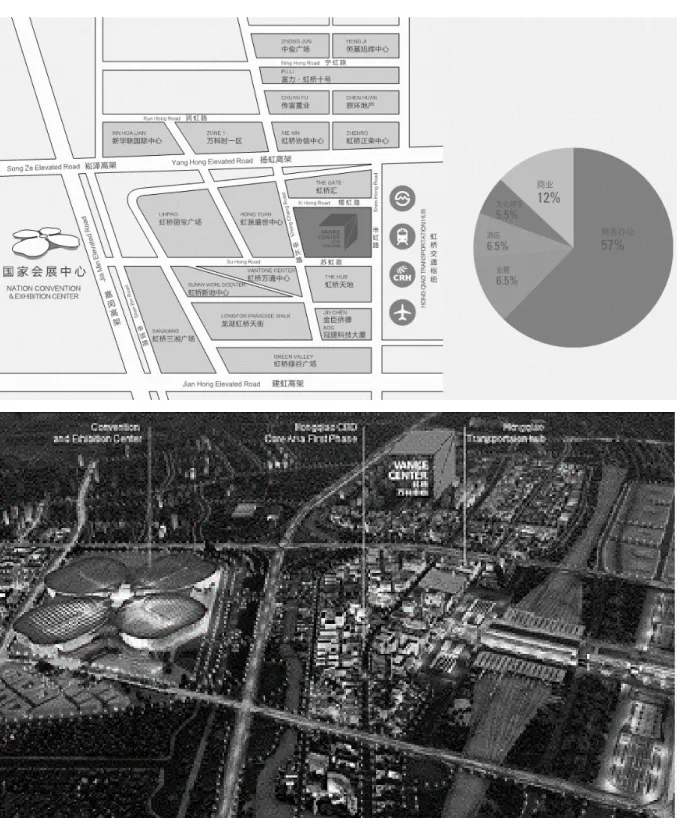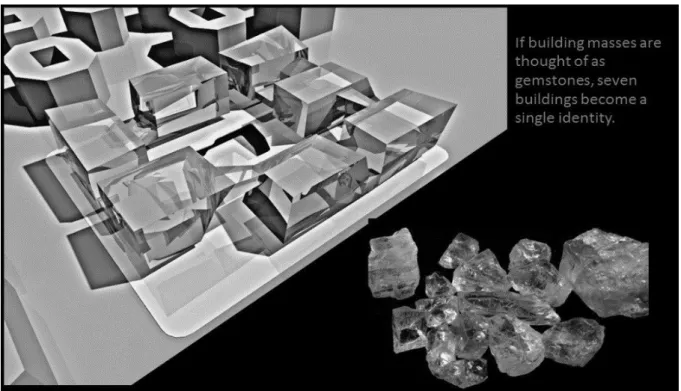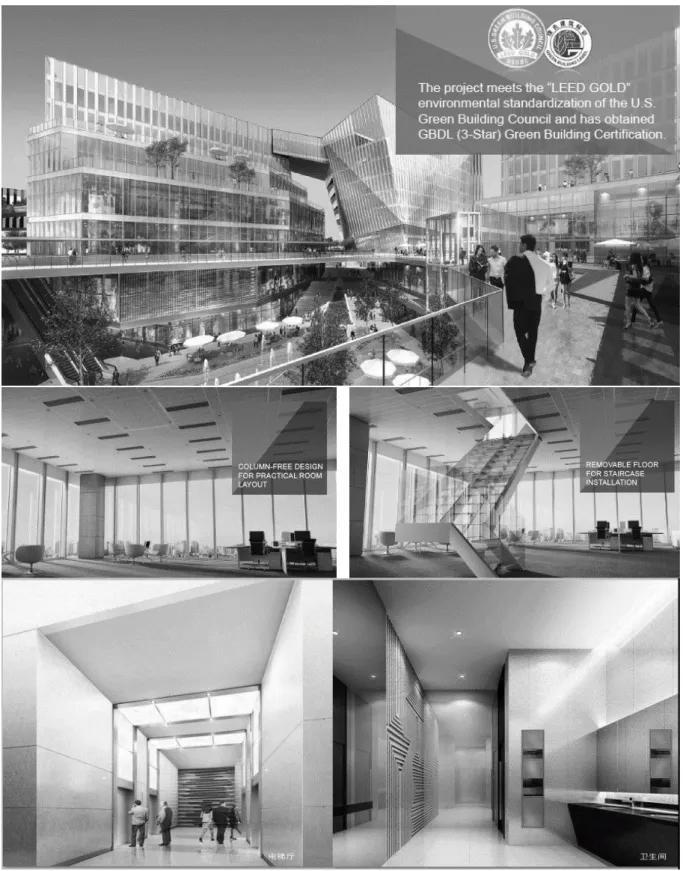IRE | BS
COMMERCIAL REAL ESTATE DEVELOPMENT IN CHINA FRAMEWORK AND CASE STUDIES
Editoren:
Prof. Dr. Tobias Just Xin Lu
Beiträge zur Immobilienwirtschaft
Heft 20
Herausgeber: IRE|BS International Real Estate Business School, Universität Regensburg www.irebs.de
ISSN 2197 - 7720
Copyright © IRE|BS International Real Estate Business School 2018, alle Rechte vorbehalten
Verantwortlich für den Inhalt dieses Bandes:
Prof. Dr. Tobias Just, IREBS
Xin Lu, ECE Europa Bau- und Projektmanagement GmbH
RECHTLICHE HINWEISE
ZUGANG
Die Publikation von und der Zugang zu Informationen in dieser Studie kann durch lokale Vorschriften in gewissen Ländern eingeschränkt sein. Diese Studie richtet sich ausdrücklich nicht an Personen in Staaten, in denen (aufgrund der Staatsangehörigkeit bzw. des Wohnsitzes der jeweiligen Person oder aus anderen Gründen) entsprechende Einschränkungen gelten. Insbesondere richtet sich die Studie nicht an Bürger der USA sowie an Personen, die in den USA oder in einem ihrer Territorien, Besitzungen oder sonstigen Gebieten, die der Gerichtshoheit der USA unterstehen, wohnhaft sind oder dort ihren gewöhnlichen Aufenthalt haben. Personen, für welche entsprechende Beschränkungen gelten, dürfen nicht, weder online noch in anderer Form, auf diese Studie zugreifen.
KEIN ANGEBOT
Der Inhalt dieser Studie dient ausschließlich Informationszwecken und stellt keine Werbung, kein Angebot und keine Empfehlung zum Kauf oder Verkauf von Finanzinstrumenten oder zum Tätigen irgendwelcher Anlagegeschäfte oder sonstiger Transaktionen dar. Diese Studie (einschließlich der darin enthaltenen Informationen und Meinungen) stellt keine Anlageberatung dar und sollte nicht als solche aufgefasst werden. Potentielle Investoren sind gehalten, spezifische Beratung einzuholen und Anlageentscheide gestützt auf ihre individuellen Anlageziele sowie ihre finanziellen und steuerlichen Gegebenheiten zu treffen.
HAFTUNGSAUSSCHLUSS
Die Autoren sind darum bemüht, dass diese in dieser Studie enthaltenen Informationen zum Zeitpunkt ihrer Veröffentlichung richtig und vollständig sind und aus zuverlässigen Quellen stammen. Die Autoren lehnen jedoch jegliche Verantwortung für die Genauigkeit, Zuverlässigkeit, Aktualität und Vollständigkeit der hierin wiedergegebenen Informationen und Meinungen ab. Die Autoren lehnen ausdrücklich jegliche Haftung für Verluste oder Schäden ab, die sich aus der Nutzung dieser Studie oder dem Vertrauen in die darin enthaltenen Informationen ergeben könnten, einschließlich Gewinnausfälle oder anderer direkter und indirekter Schäden.
Commercial Real Estate Development in China – Framework and Case Studies
Tobias Just & Xin Lu (Eds.)
I
Table of Contents
Contributing Authors... II Introductory remarks on developing commercial real estate in China ... 1
Tobias Just and Xin Lu
Chinese Culture and Its Impact on Today's Consumers and Markets ... 4
Boram Yi, Jason Q. Zhang and Qinna Shen
China office building development: a case study ... 15
Ye Ting
Chinese shopping center development – today and tomorrow ... 28
Xin Lu
Managing Real Estate Compliance Risks in China ... 46
Philipp Senff
No one-way street ... 65
Tobias Just and Chenhui Xia
Contributing Authors
PROF. DR. TOBIAS JUST is Managing Director at the IRE|BS Immobilienakademie and professor for Real Estate at the University of Regensburg. Tobias studied economics in Hamburg and Uppsala (Sweden). In 1997 he graduated and started to work at the University of the Federal Armed Forces Hamburg. His PhD-dissertation was awarded the university science prize in 2001. For more than ten years Tobias worked at Deutsche Bank Research, the economics research unit of Deutsche Bank. He headed the units’ sector and real estate research team and was a member of Deutsche Bank’s group wide Environmental Steering Committee.
In summer 2006 Tobias was Research Fellow at the American Institute of Contemporary German Studies at the Johns Hopkins University in Washington DC. Tobias published more than 150 papers in professional and academic journals and books. Since November 2011 Tobias has been Managing Director at the IRE|BS Immobilienakademie and has a chair for Real Estate at the University of Regensburg. He is President of the German Society of Property Researchers (gif), editor of the ZIÖ – the German Journal of Real Estate Research and a member of the Executive Management Board of the German section of the Urban Land Institute. In 2013 Tobias was elected “Head of the German real estate industry” by leading real estate journalists, and in 2015 he was ranked among the leading German economists by the FAZ. In 2017 Tobias became Fellow of the RICS by nomination.
XIN LU has not only extensive experience in urban planning and architectural design but also deep understanding of Chinese real estate development. Currently she is working as managing director of ECE Europa Bau- und Projektmanagement GmbH in Hamburg, a daughter company of ECE, one of the biggest shopping center developers and operators in Europe. Before she started working at ECE in 2013, she worked for the China Vanke Group, the biggest real estate developer in China with over 600 architects, as chief architect. Her career began in Stuttgart at IFB Dr.Braschel AG and she became partner of an architecture and urban planning company IBO Concept GmbH in Munich in 2004 and was in charge of its China business. She received her master for Architecture at Chongqing Architecture University in China and an additional master for Urban Planning at Bauhaus University Weimar in Germany.
As urban planning expert from China she contributed to the “Green Economy Report” for the United Nations (LSE 2010). Her book “Western Architects and City Planners in China” was published in Germany in 2008 and sold in 28 countries.
PHILIPP SENFF is Attorney-at-Law and Partner at CMS China, based in Shanghai. Mr. Senff belongs to the leading compliance and risk management lawyers with over 15 years of China related business experience. Mr. Senff has extensive experience in advising multinational companies on mergers and acquisitions, real estate transactions, joint ventures and the restructuring of business operations in China. Mr. Senff has established a reputable legal practice that focuses specifically on compliance and risk management in China, which includes business reviews, internal investigations, whistle-blower management, corporate governance, prevention and crisis management.
III
Before joining the firm, Philipp Senff was for several years the Head of the Shanghai office of a leading UK law firm. Mr. Senff has completed the Executive Education program at Stanford Law School. He is the editor of the book “Governance, Risk and Compliance Management in China: Practical Guidance for Executives” at Haufe (2018, Senff/Zhang (eds.), 520 pages). Mr.
Senff is member of the advisory board of the IWM Institute of International Real Estate Economics and Management.
QINNA SHEN is Assistant Professor of German at Bryn Mawr College. Her research interests concentrate on the areas of German studies (20thcentury), film studies, and transnational studies with a focus on Sino-German relations. She has published numerous articles in peer-reviewed journals and edited volumes.
She is active in the profession. She organized Asian German panels and seminars at the Annual German Studies Association Conferences (GSA) as well as at the International Conference of Germanists (IVG) in Shanghai in 2015. Currently, she is serving on the program committee of the German Studies Association.
Before joining the Bryn Mawr faculty in 2016, she held Visiting Assistant Professor positions at Miami University in Ohio and at Loyola University Maryland. At Bryn Mawr, she teaches all levels of German language, literature, and culture courses. She designed a number of new topical courses including “Representing Diversity in German Cinema,” “Berlin in German Literature and Film,” “German Encounters with East Asia,” “Coming of Age Stories,” and
“Crime, Justice and the Courtroom.”
YE TING graduated with a bachelor degree from the School of Economics of Fudan University in 2000. From 2001 to 2003, he worked for State Grid Corporation of China. When he was working for the Greenland Group, he established the commercial division and was in charge of all the important commercial properties in Shanghai from 2005 to 2009.
After joining Vanke, Mr. Ye was responsible for all the commercial properties in Shanghai.
These assets were valued at over 400 billion CNY. He has over 10 years experience of developing commercial properties, attracting brands, and marketing.
Since the merger of Vanke commercial and SCPG, Mr. Ye has become a partner of SCPG, vice- president of SCPG and general manager of Vanke SCPG Shanghai Corporation, in charge of all the existing commercial projects and new project acquisitions in Shanghai, Jiangsu and Anhui provinces, leading a professional commercial asset management team of over 600 people.
CHENHUI XIA is Head of Real Estate Transactions at Helaba Invest and oversees its global real estate investment programs and fund selections. In addition Chenhui is responsible for the Asian real estate fund of funds platform. He joined Helaba Invest in 2014 and is part of the real estate transactions team. In addition Chenhui is responsible for the Asian platform (Fund of Funds) and the Asian investment programs. Before joining Helaba Invest he was a Manager in real
estate structured financing at Aareal Bank Group. Chenhui studied economics in China before he came to Germany in 2002 to continue his studies. He studied management in real estate, construction and infrastructure at the Bauhaus University in Weimar and graduated with a bachelor degree in 2006 and a master degree in 2008. His master thesis “Portfolio Optimization of German Open-ended Real Estate Funds” (in German language) was published and he started to work at Aareal Bank Group as a management trainee in 2008. In 2015 Chenhui became a Chartered Financial Analyst® (CFA).
BORAM YI is assistant professor at the division of legal, ethical and historical studies at the University of Baltimore, Maryland since 2007. She has extensive teaching and research experience in U.S. history and modern Chinese, Japanese and Korean history and culture. In the past she has worked as part-time instructor at the University of Georgia, Athens and as fact- checking editor for David Halberstam on “The Coldest Winter” (New York: Hyperion, 2007).
After studying English Literature and Language as well as American Studies in Korea, she received a MA degree (2000) and Ph.D. (2006) in History at the University of Georgia, Athens.
She is a member of the American Historical Association as well as the Society for Historians of American Foreign Relations.
JASON Q. ZHANG is the chair and associate professor of the marketing department at the Sellinger School of Business, Loyola University Maryland. He holds a doctoral degree in business administration (concentrated in marketing) and master's and bachelor's degrees in statistics and finance. His research focuses on marketing strategies and analytics in various business contexts, including social media, branding, ROI of marketing, and corporate social responsibility. His work has appeared in premier academic journals and received recognition from leading research institutions, such as Marketing Science Institute, the Wharton School at the University of Pennsylvania, and the Lattanze Center of Information Management Systems.
Prior to joining Loyola, Jason taught at the University of Georgia. Before that, he worked as a management consultant. Presently, Jason teaches marketing management, services marketing, and strategy courses at the undergraduate, graduate, and executive levels. He also regularly teaches doctoral and executive classes overseas with a particular interest in China. His teaching and executive training has won him numerous awards, including the EMBA Teacher of the Year (three times) and the University’s and Dean’s Teaching Excellence Awards. His graduate classes also enjoyed appearance in the popular press including the Baltimore Sun.
1
Introductory remarks on developing commercial real estate in China
It is easy to be impressed by China’s size and even more by its growth story over the last forty years. In 1980, GDP per capita in China stood at 300 USD (in current USD). Today, this value is 25 times higher. And if we control for purchasing power, the momentum has been even greater.
At the same time, the number of inhabitants of China has risen by 500 million, to almost 1.4 billion people today – despite the one-child policy intended to mute population growth in the 1970s. This rising population is living increasingly in cities. Almost 800 million Chinese live in cities, and the number of big cities has been increasing rapidly. According to the latest data published by the UN population division, there are 109 cities in China with more than 1 million inhabitants, totaling an urban population in these larger agglomerations at almost 350 million people. In 1980, there were not more than 18 cities with more than one million inhabitants.
This has resulted in enormous metropolises. According to the UN Population database, there are more than 18 million people living in Beijing, more than 23 million in Shanghai and 12 million in the agglomeration areas of Chongqing or Guangzhou. And even though these cities have more than tripled their number of inhabitants since 1980 – in fact, the number in Guangzhou is now six times higher than 35 years ago – these impressive numbers are dwarfed by the growth momentum of cities that were small at the beginning of the growth story. In more than 100 Chinese cities, the number of inhabitants grew by more than 900% within just 35 years. In Dongguan today, the population has increased by more than 5000% since 1980, and in Shenzhen, of course an extreme outlier, the number has risen by a factor of 190 compared to 1980. A village was transformed into a megacity within just one generation.
Obviously, real estate and the building sector have been a key driver of the Chinese growth story, and even though the growth momentum seems to be tapering off from a very high level, there is still significant room for new developments and improvements. This includes a growing need to refurbish and upgrade existing stock that was built rapidly in earlier decades and is not suitable for the needs and preferences of a wealthier and more urban population.
These urbanization efforts required millions of new residential units. Residential construction has been playing the most prominent role in the last four decades within the China real estate growth story. However, the skylines of Shanghai and Shenzhen are not only shaped by residential buildings, non-residential skyscrapers have also changed the cities’ appearance.
Similarly, commercial real estate was transformed from mom-and-pop-shops dominating retailing into modern shopping centers that are often bigger than European centers. Figure 1 illustrates the still enormous activity that is taking plece in China’s development and investment markets.
Fig. 1 Expanse of real estate in China in 2016
Sources: National Bureau of Statistics in China, Statista
It is impossible to ignore the development in China, as the growth story has many implications for European real estate players; they can benefit as investors, as designers, as technical, legal or financial advisors and of course, it is likely, that Chinese real estate markets will need more asset managers, property managers, portfolio managers and risk managers than today. In that sense, Chinese real estate markets are professionalizing rapidly. Nonethleless, China is not an easy market. Market dynamics and fundamentals are similar to everywhere else in the world, but the framework and mindset remain different and likely to stay so, even though the maturing markets will lead to comparable investment, building and financing standards.
This process, however, is not likely to follow a linear path. Therefore, while it is important to be interested in the developments in China, it is equally important to remain prudent and cautious. What is more, China is not only a destination for international capital and know-how, it is turning increasingly into a complex mutual exchange: capital is moving out of China into international real estate projects and Chinese know-how is also moving out. Therefore, even those who are not interested in entering the Chinese real estate market, should have a general understanding of this economic giant.
With this brief reader, we want to raise attention to the various issues and offer a first foothold, by sketching four different aspects of developing commercial real estate in China.
First, the article by Boram Yi, Jason Q. Zhang and Qinna Shen provides a brief introduction to Chinese business culture. It is important to note, however, that a new type of international business culture has also emerged, as an increasing number of Chinese managers have been receiving professional training in the US or Europe. Second, the two articles by Xin Lu and Ye Ting detail with a case-orientation, how retail and office developments are conducted in China.
While Xin Lu’s article deduces current developments for shopping center developments from retail trends and the regulatory framework, Ye Ting’s article illustrates a specific case study of
6.870
1.584
1.151
653 1.375
108 52 38
0 200 400 600 800 1000 1200 1400 1600
0 1000 2000 3000 4000 5000 6000 7000 8000
Residential property
Commercial property
Other Office property
in bn RMB in million m²
in bn RMB: developer investments, left-hand scale in million m²: Expanse of real estate sold, right-hand scale
3
a green and modern office building. Third, Philipp Senff’s paper focuses on the important aspect of compliance, which is rapidly gaining importance in China. Finally, Chenhui Xia and Tobias Just show it has become equally important to analyze the Chinese capital outflows and inflows.
The second largest economy in the planet will increasingly need to diversify its portfolios.
There might be cycles in regulatory frameworks, but it is highly likely that European real estate professionals will in the future see more Chinese investors and capital in their own home markets. Thus, one should start learning about these new players as soon as possible, and keep on learning.
Tobias Just and Xin Lu
Frankfurt/Hamburg July 31st, 2018
Chinese Culture and Its Impact on Today's Consumers and Markets
Boram Yi, Jason Q. Zhang and Qinna Shen
Abstract°° The dynamic Chinese market is attractive to many foreign businesses. In order to successfully interact with the local businesses and consumers, foreign executives need to understand Chinese culture and its impacts on today’s Chinese consumers, markets, and business practices. In this chapter, the readers will learn about the roots of Chinese culture and its implications. The chapter highlights a few influential concepts, e.g., gunaxi and feng shui, and explains their significance in building a successful business venture in China.
Key words: Chinese culture, Chinese market, feng shui, guanxi
1 Introduction
Since the 1980s, the world has witnessed the meteoric economic growth of China. Today, the size of the Chinese economy is second only to that of the United States. The importance of the Chinese market was spotlighted during the recent global financial crisis. As one example, with prolonged economic contraction, the size of Russia’s economy (measured by its 2015 GDP) is about the same to that of Guangdong Province, one southern province in China (the World Bank, 2015; the National Bureau of Statistics of China, 2015). As a response to the sheer size of Chinese economy, foreign businesses increasingly view China as a strategic market.
Popular media and business magazines in the United States rushed to assist this trend, publishing numerous articles with eye-catching headlines such as “Doing Business in China:
Five Tips for Success” (CNN, 2011), “The Ten Principles for Doing Business in China,”
(Forbes, 2012) and “10 Subtle Cultural Mistakes You May Make Doing Business in China”
(Bloomberg News, 2014). Such publications commonly touch on distinctive characteristics of Chinese culture and business practices, which are often at odds with established practices in the West.
While recurring topics in the popular press touch on the collectivistic and hierarchical nature of Chinese culture and society, they often leave a more fundamental question unanswered: What are the historical, cultural, and social foundations that underlie these phenomena and practices?
A clear understanding of their conceptual roots can provide useful insights for and guides to foreign executives and investors and enable them to interact with their Chinese counterparts in an effective manner. This chapter offers an overview of Chinese history, culture, and society, highlighting major differences as well as similarities between China and the West. The aim is to explain how the Chinese ideals of life impact today’s customers and markets and how these ideals evolve and adapt to those of the West in a globalized world.
5
2 History, Society, and Culture that formed Chinese Worldviews
Chinese civilization is one of the oldest living civilizations in the world. Over several millennia, the Chinese have developed prevailing worldviews that shape their cultural values and societal norms. Understanding these views and the ways in which they affect the Chinese understanding of an ideal life—a key motivation for consumer behavior and business practice alike—are a crucial first step for foreign executives and investors seeking to effectively interact with the Chinese. Here we discuss the Chinese vision of an ideal life, that is, harmonious living as it is manifested in three essential human relations—with nature, with gods and with other people—that are influenced by China’s two indigenous philosophies, Daoism (or Taoism) and Confucianism.
2.1 Humans and Nature
The Chinese have long believed that living in harmony with nature is one of the three pillars constituting an ideal human life. Influenced by Daoism, ancient Chinese thought that nature runs its own course and should be left alone without much human interference. Daoism informs that humans are a crucial component of the natural world, but not its masters, thus need to follow the flow of nature’s rhythms —forming a sharp contrast to the Judeo-Christian belief that humans are the masters of nature. Daoism also teaches that by aligning themselves with nature (i.e., being part of the nature as opposed to being an outsider/master to it), humans can achieve the optimum level of their moral and physical strength. This idea exerts a lasting impact on Chinese aesthetics, shown in art and practiced through feng shui, a way to locate, design, and construct an ideal human dwelling according to the flow of nature.
2.1.1 Nature in Chinese Art and Aesthetics
Chinese art, particularly painting and garden design, well illustrates the ideal relationship between humans and nature in Chinese thought. When a Chinese artist portrays a human subject, this subject’s individuality is often obscured. The artist often places the individual within a natural setting or in a particular social group. Renowned anthropologist Francis L. K.
Hsu notes that a Chinese artist either treats a man as a minute dot in a vast landscape, or dramatizes his external situation in which a viewer can discern the status, rank, prestige, and other social characteristics of the subject (Hsu, 1981). To live harmoniously with nature, thus, means that humans should recognize their place in the natural world and in society, respect the flow of nature and society, and follow it.
The idealized relationship between humans and nature is also expressed in Chinese garden design which aims to “recreate the image of nature while accommodating the sophisticated needs of retreat or habitation” (Tsu, 1987). As a result, curves and studied irregularities—those mimicking nature— characterize Chinese gardens, such as the famous Suzhou Gardens.
Landscapers avoid stiff orderliness and geometrical rigidity of a typical French garden style, epitomized in the Gardens of Versailles. Broad central walkways, straight paths, and symmetrical lawns, commonly found in French and Italian gardens, are exotic to China.
Structures such as pavilions are deliberately constructed as sheltered parts of the garden, rather than discrete buildings, and thus form an indispensable part of the landscape. This design philosophy reinforces the idea that humans are an important part of the natural world. When
seeking an exotic experience, the Chinese could adopt a foreign design, but would still prefer to keep that design separate from the rest as illustrated in the two most famed imperial gardens in Beijing first built in the mid-1700s: Yihe Yuan (The Summer Palace Gardens) follows the traditional Chinese style whereas Yuanming Yuan (The Perfect Brightness Gardens) follows the Western style.
2.1.2 Nature’s Force: Feng Shui and Its Impact on the Real Estate Market
The Chinese pursuit of living harmoniously with nature is pronounced in their adherence to feng shui principles. Originated in China more than three thousand years ago, feng shui exerts an extraordinary influence on architectural designs both inside and outside man-made structures. Literally meaning “wind and water,” feng shui’s basic principles are to avoid strong winds and to hold water in order to accumulate qi (or chi), the vital energy that is believed to support all life. The Chinese believe that the residents of the property with positive qi would enjoy health and wealth as well as increase their wellness of being and avoid misfortunes. A good feng shui site is located in the lee of a mountain or surrounded by hills that provide good protection against winds. It also has ready access to fresh, clean water and is protected from flooding. For maximum heat and light, the front of a building should receive ample sunlight, which means that in the northern hemisphere, where China is located, a home’s main rooms should face south or south-east. By linking the placement of objects to human lives, feng shui teaches that people are affected by their surroundings and by the layout and orientation of man- made structures. In essence, it maintains that a place is capable of influencing the quality of human life. Thus, finding a way to live in harmony with one’s immediate physical surroundings, nature, and the universe is the major pursuit of feng shui.
The principles of feng shui apply not only to the location and orientation of a dwelling, but also to the arrangement of its interior because the flow of qi within a structure is believed to affect its residents. For instance, a direct path from the front door to the back door is avoided because it would allow wind going through these doors to take away qi. For the same reason, the Chinese do not like houses that are located at a T-junction because they are more likely to be buffeted by gusts of wind. On the other hand, feng shui also offers remedies for structures that are poorly designed. Often a shoji screen is added inside a gate or the door of a house to block the wind and thus to ensure a better hold of qi.
The belief that a location affects residents’ health and wealth makes feng shui a prominent concern in the Chinese residential real estate market.Among the wide range of factors that affect the buying decisions, including physical and environmental concerns, the spiritual significance of a site or the luck a particular location might bring to its residents is considerably important. A study shows that properties judged to have negative qi often cost between 30 to 50 percent less than comparable homes with better feng shui (Sun, 2006; Wu et al., 2012). A case study of property development in fifteen villages in Hong Kong found that the most significant determinant of the cost of housing is feng shui (Tam et al., 1999). Real estate developers in Hong Kong consult feng shui masters before they start construction (Stapleton, 2016). A British investigative report revealed that the Hong Kong government had been paying substantial amount of compensations to people living around public construction projects for disturbing their feng shui (Moore, 2010). Although some may dismiss feng shui as a superstition, recent academic attentions given to the topic recognize its relevancy in the minds of Chinese consumers. In 2012, a prestigious U.S. academic journal, Psychology & Marketing, devoted an entire issue to the study of consumer psychology involving feng shui and its effects on buying decisions.
7
Another aspect of feng shui, numerology, also helps explain why some properties are valued higher than others with similar specifications. Certain numbers may cue prosperity and thus be favored; others may be the opposite. For instance, number “eight” is well liked because it is pronounced similarly to the Chinese word for fortune, whereas “four” is avoided because it sounds like the word for death. Westerners have similar associations with the numbers seven and thirteen. It was not a coincidence that the Chinese government scheduled the opening ceremony of the 2008 Beijing Summer Olympic Games at eight p.m. on the eighth day of August, the eighth month of 2008, making it a very auspicious occasion. An apartment on the eighth floor or a home that contains eight in the address usually commands higher price.
Foreigners considering operating a real estate business in China should take note of feng shui.
Their awareness of this custom demonstrates their respect for Chinese traditions and sincere interest in doing business in the country, thus making them more attractive business partners as well as reducing the chances of conflict with local population.
In the United States, residential real estate developers in areas with a high concentration of Asian-Americans have adopted some feng shui principles, too. For example, they avoid placing the main staircase opposite the front door, as it takes away qi (Bryan, 2014). In 2014, a condominium in Washington, D.C., was built in accordance with feng shui principles. Well- known American companies like Whole Foods Market, McDonald’s, and Disneyland use feng shui to help identify optimal building locations and designs, as reported in the Washington Post (Chodorov, 2014). Some Asian-American residents in Canada took action to protect the value of their real estate by maintaining good feng shui. In 2011, a plan to build a hospice near a luxury condominium in Vancouver was opposed by the condo owners, who were mostly of Chinese heritage. They cited feng shui as the reason for their opposition and called the building plan “culturally insensitive” (CBC News, 2011). According to feng shui, a place of grief, sadness, sorrow and death generates negative energy that negatively affects the well-being of nearby residents. Thus Chinese avoid living close to funeral homes, cemeteries, hospitals, and hospices. In 2013, Asian-American residents in Atlanta, Georgia, used the same argument when protesting a zoning decision that permitted the construction of a funeral home next to their subdivision (Hurd, 2013). Thus, failure to pay close attention to Chinese ideals could cost investors dearly for their efforts to reach Chinese consumers either in China or beyond its borders.
2.2 Humans and Gods
Just as they seek to live harmoniously with nature, the Chinese seek to do the same with the supernatural world. The Chinese tradition in its pragmatic and secular outlook has long embraced polytheism. To ensure that they maintain harmonious relations with multiple gods, the Chinese would provide material offerings and spiritual reverence to several gods. It is not surprising to find the deities of Confucianism, Daoism, and Buddhism share the same temple.
In fact, this is so common that the Chinese language has a term to describe this unique phenomenon: “the Union of Three Religions.” A Confucian scholar, for example, would not object to his wife or children making offerings to the Buddha. The Chinese see no contradiction in living with diverse religious traditions and supernatural beings (Koller, 2012).
With the absence of an absolute god and relatively little attention given to the afterlife, the Chinese turn their focus to secular human relationships in their search for the meaning in life.
This explains why Confucianism, among all competing schools of thought, has prevailed in China. It is a system of ethics based not on abstract, supernatural, or absolute doctrines, but on the everyday duties and obligations between individuals that aims to preserve an orderly, harmonious way of living. The Chinese stress strong bonds with family and community which is maintained with the utmost sincerity and almost religious devotion. This strong tie is continued to be honored even after an individual’s death in the form of ancestor worship.
Traditional Chinese homes usually have a separate room, or a shrine, to commemorate and worship the family’s ancestors. In the center of a village is often a shrine or temple that celebrates the ancestry of that village.
2.3 Humans with other Humans
2.3.1 Interpersonal Relationship in Chinese History, Society, and Culture
The last of the three pillars of fundamental human relations is an interpersonal relationship.
Confucianism, the foundation of Chinese culture and society, teaches that an ideal life can be attained in an interpersonal relationship when each individual occupies his/her proper place and fulfills the obligations inherent in the five cardinal relationships. These are the relationships between ruler and subject, father and son, husband and wife, between brothers, and between friends. Confucianism emphasizes, in this essentially hierarchical structure, that all individual exist in relationship to one another. This notion works to strengthen an individual’s ties to his/her primary group.
Because of such a strong emphasis on primary group cohesion, anthropologists describe the Chinese as “situation-centered” (Hsu, 1981). Similarly, scholars of cross-cultural studies categorize Chinese culture as collectivistic as opposed to individualistic. As such, social status and identity are determined largely by one’s relationships, which in turn, determine his/her power and influence as well as his/her feelings of self-esteem and sense of security (Hofstede, 2003; Feldman, 2013). According to an influential researcher Geert Hofstede (2003), Chinese culture is “highly” collectivistic.
The contrast between the Chinese collectivistic view and the American individualistic view was exemplified in a series of highly publicized acquisition attempts made by a Chinese firm to purchase American properties. In spring 2016, the Anbang Group, a Chinese insurance company, which previously acquired the historic Waldorf-Astoria hotel in Manhattan, bid $14 billion to purchase Starwood Hotels & Resorts, one of the largest hotel chains in the world and the owner of St. Regis, Westin, and Sheraton brands. During the process of acquisition negotiation, Western media pointed out the Chinese company’s rather unconventional approach to negotiations. They described how Anbang’s CEO followed “his own style” and often surprised Starwood negotiation team. For instance, the CEO would call for last minute meetings during peak vacation seasons and even on Easter Sunday (Sender, 2016). Frustrated Starwood executives had to rearrange their vacation and holiday plans. As another example, during business negotiations, when the Anbang CEO was present, his top legal, banking, and negotiation advisors, mostly trained in the U.S., stayed completely silent without offering opinions. This “unusual” approach might be a shock for American executives, but it is fairly common for the Chinese who learned to submit their personal goals to collective/organizational goals and to respect the authority particularly in public (Karmin, et al., 2016).
9
2.3.2 Centrality of Interpersonal Relationship: Guanxi and Its Impact on Business Practices
The primacy of interpersonal relationship over others is a key to understanding the concept of guanxi, which literally means a relationship, connection or network, and is variously rendered in English as “Chinese relationships and networks,” “interpersonal networking” or the
“art of relationship.” To the Chinese, guanxi is not only the art of networking but a way of life ingrained in their society and culture for several millennia by their belief in the importance of harmonious human relationships. It is a proper moral code: the Confucian emphasis on ethical living through harmonious relations created the elaborate unwritten rules governing the reciprocal exchanges of gifts and favors that unite and expand interpersonal ties. But guanxi is also a practical mechanism of self-preservation: the predominantly agricultural Chinese have long relied on guanxi to weather the unpredictable forces of nature as well as sudden changes in political power. It is expected that extended family members will assist each other in times of need. An American anthropological economist goes so far as to describe guanxi as the
“payment of a premium for residential fire insurance” (Bell, 2000). Guanxi is so pervasive in Chinese culture and society that the proper practice of its implicit rules is critical for business success in China.
Guanxi enables people to accomplish a common interest through the exchange of favors between trusted individuals. Thus, two key components of the system of guanxi are the principle of reciprocity and mutual trust. The principle of reciprocity is a cultural force, “a sort of cultural invisible hand that makes possible group effectiveness and identity over time” (Feldman, 2013).
This deeply imbedded cultural element explains why guanxi is much more complex than the Western concept of networking, and it also explains why foreign executives who approach guanxi solely from a business perspective quickly hit an impasse. For most Chinese, building a close friendship is a prerequisite for discussing business. A potential partner needs to prove himself/herself trustworthy and truthful and to demonstrate that he is willing to take time and effort to gain the trust of others before embarking on a business venture. Shared meals, drinks, and exchanges of gifts are meant to build that trust. In this ritual, a gift is not exchanged to procure a particular favor. Rather, it is a way of developing positive feelings to initiate a relationship (Feldman, 2013). The Chinese often take things slowly and carefully, especially in forming guanxi. Thus, in building the typical sales funnel (i.e., closing a business deal from prospecting to making the sale), foreign executives should consider a longer than usual lead time.
Professor Roy Chua of Singapore Management University further clarifies guanxi by contrasting the building of trust “from head and heart” (Chua et al., 2009). Trust from the head emanates from the confidence one has in a person’s accomplishments, skills, and reliability.
However, trust from the heart, or affective trust, arises from feelings of emotional closeness, empathy, and rapport. Most friendships and personal relationships are based on the second type of trust. In general, Western executives draw a fairly clear line between trust from the head (i.e., trust based on competence) and trust from the heart (i.e., trust based on affect) in business relationships. For example, a study by Chua finds that American executives are nearly twice as likely as their Chinese counterparts to separate these two types of trust. They consider mixing the two as an unprofessional behavior that creates the risk of conflict of interest. Among Chinese executives, however, there is a much stronger interplay between trust from the head and trust from the heart; they are quite likely to develop personal ties and affective bonds when there is also a business or financial tie (Chua, 2012). Blurring the boundary between one’s personal and professional life often surprises Westerners. During a business banquet, a Chinese
manager may ask personal questions about his/her counterpart (e.g., age) as a gesture of courtesy (e.g., an old age is usually associated with elevated social status and position, thus being an important piece of information for the Chinese to properly address them and arrange seating at the table accordingly), which would be considered intrusive in the West.
It needs to be noted that in today’s rapidly changing China, a growing number of Chinese companies start to subscribe to Western business norms. As a result, some high profile firms start drawing a clear line between personal and professional relationships and viewing gift- giving as ethically questionable practices, effectively adopting the “trust from the head”
approach. As one example, the founder of China Vanke Company, the largest real estate developer in the country, is famously known for his motto, “no bribery of any kind” (Larmer, 2008). Firms like Vanke look more carefully at a potential partner’s competence to add value to their business and pay increasingly less attention to building personal/emotional ties with them. In these cases guanxi comes to resemble conventional business networking as practiced in the West. The story is told of a Chinese company that rejected an offer from a Western firm that devoted too much energy to providing lavish banquets and gifts, but not enough to demonstrate their competence to its prospective business partners (Chua, 2012).
This observed shift in business culture, however, does not necessarily mean that the Chinese have abandoned the practice of trusting someone from the heart. For instance, the establishment of a business relationship continues to be understood as the start of a personal relationship.
Thus, it remains customary to include dinners into business itineraries as an expression to celebrate the start of a new relationship, even when lavish banquets are no longer offered. For another example, it is not uncommon that affective ties often triumph over competence when the two conflict with each other in business decisions (Chua, 2012). Thus, in the Chinese market, although business norms and standards may quickly adapt to those of the global market, human behaviors, including those of business executives, are still anchored deeply in China’s cultural roots.
As an interesting note, Chinese thoughts and business practices in guanxi find their way into mainstream Western business philosophy. Relationship marketing, a notion and philosophy introduced into business literature in the late 1980s and early 1990s, stresses long-term, relationship-based, and often emotional connections between firms/brands and their customers.
In fact, relationship marketing or customer relationship management (CRM) has become one of the most important concepts in recent development of marketing theory and practice.
Numerous academic researchers and practitioners examine the relationship between relationship marketing and firm’s performance (Samaha et al., 2014). The Chinese may think Westerners are finally appreciating what they have practiced for a very long time.
A good understanding of guanxi and the centrality of interpersonal relations is a key to success in China, be it in business, politics, or any other area that requires personal interactions.
Although guanxi as it is practiced in China is evolving, its deep roots in harmony, reciprocity, and orderly hierarchy continue to be manifested in today’s consumer and business behaviors and decisions. Instead of being a barrier to business, when practiced appropriately such as in relationship marketing, guanxi may be mutually beneficial to both buyers and sellers. After all, contractual bonds can be legally broken if needed, but emotional and social bonds, once formed, are much harder to break.
11
3 Conclusions
Throughout their long history, the Chinese have preserved the ideal of living in harmony with their surroundings. They believe in living harmoniously with nature because humans’
physical and material conditions are assumed to be susceptible to the flow of nature, as evident in their adherence to the principles of feng shui. Belief in living in harmony with the supernatural world led them to comfortably coexist with multiple faith traditions. While the Chinese have been less concerned with seeking an absolute truth in the supernatural world, they have paid more attention to building an ideal, harmonious society in this world, as prescribed by Confucianism. They believe that when individuals identify with their primary groups and fulfill the roles expected of them, a harmonious and orderly society can be achieved. Within the group, cooperation in a wide range of areas, personal and professional, is the norm.
Thus, to build a trustworthy business relationship, in addition to demonstrating competence, business executives and managers are usually expected to be willing to build personal connections with their trading partners. The focus, often times, is more on a long term relationship and its benefits and less on a particular transaction and the resulting one-time gain or loss. Within this context, Chinese entrepreneurs tend to find comfort in the presence of personal trust (a form of social or psychological contracts) whereas their Western counterparts likely to seek security in legal contracts. This process of cultivating personal relationships is broadly called guanxi. Once a Chinese partner takes someone in as a friend, the relationship tends to endure. Time to develop guanxi is, therefore, a critical investment.
An understanding of the roots of Chinese customs and practices will provide an advantage for foreigners seeking to do business with the Chinese. This understanding, however, must be accompanied by an awareness that dynamic changes are occurring in today’s China.
Throughout the first two decades since it actively sought to return to the global market in 1979, Chinese business communities and consumers had been eager to adopt many Western systems (e.g., social and business values, norms and standards). As a result, many of today’s Chinese business people and consumers have become familiar with wide range of changes (or “reforms”
as the Chinese call them) occurred during this period. In fact, today’s younger generations of business executives, if trained in Chinese educational institutions, have actually received business education based on the curriculum developed in American/Western institutions. In 2001, when China eventually joined the World Trade Organization, the country celebrated it as a seal of proof for their effort.
For this reason, Westerners may find Chinese culture and its consequences in people’s behaviors less distinctive. However, as China’s economy has become increasingly successful in recent years, the Chinese began to take more pride in their own cultural and social identities.
As a result, many Chinese are re-discovering their cultural roots and preferences. Today, Chinese consumers tend to favor products/services considering local tastes. Multinational firms such as Unilever and BMW all introduce unique products/brands that serve only the Chinese customers. Like any other, Chinese culture and society is live and thus ever changing. Any stationary view on them is less than ideal. At the same time, as shown in the chapter, the roots of culture, or the fundamental worldviews, hold lasting power to inform and to predict the changes in society.
4 Key Takeaways
1) The Chinese vision for an ideal life is anchored in the three pillars of human relationships—living in harmony with nature, gods, and other people. This ideal continues to provide a critical guidance to the Chinese consumer and business behaviors and decisions.
2) Competence matters in a business relationship, but willingness to build personal connections can be equally or more important.
3) Time to build guanxi is a critical investment. The Chinese focus more on long- term reciprocal interests and less on short-term transnational interests.
4) Feng shui is relevant. It is a significant consideration in the real estate market. Simply dismiss it as a superstition may cost relationship and investment.
13
Bibliography
Bell D (2000). Guanxi: A nesting of groups. Current Anthropology 41(1), 132-138.
Bloomberg News (2014). 10 subtle cultural mistakes you may make doing business in China.
Bloomberg.com, Published 10 July 2014.
Bryan M (2014). To sell a house in California, it might need good feng shui. NPR News, Published 7 June 2014.
CBC News (2011). B.C. luxury condo owners oppose hospice: Opposition centres on cultural issues, owner says. CBC News, Published 13 January 2011.
Chamberlain L (2005). Using feng shui in offices and stores. New York Times, Published 10 June 2005.
Chodorov J (2014). Logan Circle condos to use feng shui. Washington Post, Published 20 January 2014.
Chua RYJ (2012). Building effective business relationships in China. MIT Sloan Management Review 53(4), 27-33.
Chua RYJ, Morris MW and Ingram P (2009). Guanxi vs networking: Distinctive configurations of affect- and cognition-based trust in the networks of Chinese vs American managers.
Journal of International Business Studies 40, 490-508.
CNN (2011). Doing business in China: Five tips for success. CNN.com, Published 21 October 2011.
Feldman SP (2013). Troubled in the middle: American-Chinese business relations, culture, conflict, and ethics, Routledge, New York.
Forbes (2012). The ten principles for doing business in China. Forbes.com, Published 6 March 2012.
Hofstede G (2003). Culture’s consequences: Comparing values, behaviors, institutions, and organizations across nations, 2nd edn. Sage Publications, London.
Hsu FLK (1981). Americans & Chinese: Passage to differences, 3rd edn. University Press of Hawaii, Honolulu.
Hurd H (2013). Culture shock: Neighborhood protests funeral home zoned next door: Asian residents call it religious issue. North Fulton Herald, Published 13 November 2013.
Karman C, Mattioli D, and Carew R (2016). Behind Anbang’s curious Starwood courtship.
Wall Street Journal, Published 3 April 2016.
Koller JM (2012). Asian philosophies, 6th edn. Routledge, New York.
Lamar B (2008). Building wonderland. New York Times, Published 6 April 2008
Moore M (2010). Hong Kong government spends millions on feng shui. The Telegraph, Published 16 December 2010.
Ramirez M (2005). Real-estate agents studying feng shui to help sell houses. The Seattle Times, Published 2 August 2005.
Samaha SA, Beck JT and Palmatier RW (2014). The role of culture in international relationship marketing. Journal of Marketing, 78(5), 78-98.
Sender H, Massoudi A and Weinland D (2016). Inside the deal: how Anbang’s chairman Wu nearly landed Starwood. Financial Times, Published 5 April 201604.05.
Stapleton P (2016). How the questioning mind of a scientist can help Hong Kong students discover the truth about beliefs such as feng shui. South China Morning Post, Published 18 February 2016.
Sun S (2006). 5W strategies of opening a store. Li-ai Magazine, October, 83-84.
Tam CM, Tso TYN and Lam KC (1999). Feng shui and its impacts on land and property developments. Journal of Urban Planning and Development, 125(4), 152-163.
Tsu FFY (1987). Landscape design in Chinese gardens, McGraw-Hill, New York.
Wu W, Yau OHM and Lu H (2012). Feng shui principles in residential housing selection.
Psychology & Marketing, 29(7), 502-518.
China office building development: a case study
Ye Ting
Abstract°° China is the world’s second largest economy, and this is reflected directly in a strongly rising demand for office space by Chinese public administrations, as well as both domestic and foreign tenants. As a consequence, investors, real estate developers and financial institutions are paying more attention to the potential of office buildings in Chinese conurbations. In this paper, we present a case study of the development of an office building in Shanghai. Shanghai is China’s economic powerhouse, its financial center, trade center and shipping center. Developments in Shanghai therefore provide insight into potential future developments in other Chinese cities. This chapter looks at the Hongqiao Vanke Center in Shanghai, and considers the development process as well as the key success factors for developing office buildings in China.
1 Development Process of Office Buildings in China
1.1 Brief Overview of China’s Real Estate Market
Real estate in China can be divided into commercial and residential properties, as in other economies. However, what differs are the different business models that investors and developers typically adopt in residential and commercial property markets in China:
Residential real estate: Developed primarily for direct sales in order to achieve maximum short-term profits through a rapid turnover of invested equity.
Commercial real estate: Developed primarily for longer holding periods. The key difference is that the operation of the property is a key element of the development and investment plan. The project management capacity reflects this different value chain accordingly.
1.2 The Development Process of Office Buildings
This process consists of six phases: site selection and acquisition, market research and positioning, confirmation of the project design proposal, project development and construction, investment and operations, and disposal of assets.
For residential developments, the first three phases as well as the sales process are of the utmost importance in China, whereas for commercial developments, the emphasis is more on the middle three phases. Of course, for both asset classes, all six phases are relevant, but developers place a somewhat different emphasis on the respective phases.
Land selection and acquisition: Prior to the development of commercial real estate, it is necessary to obtain the land-use right from public administrations and organizations, or
from previous owners. In China, the land-use right for commercial property is valid for 40 years and for office property, 50 years.
Market research and positioning: Market research is important both before and after acquiring the piece of land. Before the acquisition the developer needs to know whether he can afford the land price. After the acquisition, a detailed analysis of demand and completion are crucial. As Chinese developers move so rapidly, it is very often necessary to adjust analyses constantly to new developments.
Project design and engineering: Typically, the development cycle of commercial real estate is longer than that of residential real estate. By and large, it takes 12 to 18 months to develop residential units in China, while developing commercial real estate takes at least three years.
Project investment and operations: Depending on the early positioning and design proposal of the project, the following two steps are important: for retail properties, attracting capital is fundamental, for office buildings, early lease contracts are most important before or shortly after completion of the project. As commercial properties are typically not directly sold, an asset management team needs to handle the
operations after commencing the project.
Disposal of project assets: For commercial properties, a disposal of assets is usually only initiated after a certain period of effectively operating the project.
Considering the comparatively long-term nature of commercial real estate developments, as well as the dynamics of the Chinese real estate markets, it is important that developers reconsider their strategies and next steps in every single phase of this process. This comprises an analysis of the national and international economic environment, as well as changes in user preferences and requirements.
2 Success Factors for developing Office Buildings in China
These factors can be grouped into three categories:
Company and team-related factors
Factors related to the macro environment
Factors related to the competitiveness of the building itself
2.1 Company and team-related factors
Success prerequisites: The corporate DNA, financial strength and team spirit are the necessities for the success of the project, as they allow for quick and effective action and reaction to market movements.
